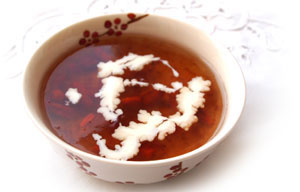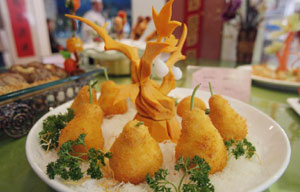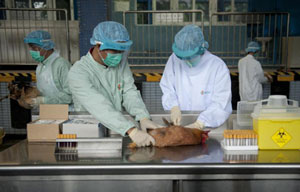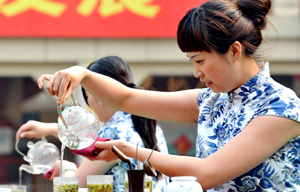

Related: The lure of cured foods
A seven-episode documentary series on the country's favorite subject has stirred up a crest of culinary interest including millions of blog entries and an increase in sales of regional snacks and traditional foods. Our team of writers spread out to take the pulse of the producers, directors, consultants and viewers of A Bite of China.
In the week that it aired on national television from May 14 to 22, A Bite of China caused the ratings to spike like never before. This seven-episode documentary was originally commissioned by China Central Television (CCTV) for its dedicated documentary channel, CCTV 9, and was mooted and produced by the Channel 9's program director, Chen Xiaoqing. When the series debuted on CCTV 1, the station's main channel, there was an increase of 30 percent in viewer ratings, knocking off the drama serials that were normally aired in that prime-time slot. According to Liu Wen, general supervisor of CCTV 9, A Bite of China was an instant hit, chalking up 2 million tweets on Sina Weibo. The ripple effect continued to spread as Web users went online to ferret out the various traditional foods and delicacies mentioned in each episode. China's biggest online shopping portal Taobao.com said the number of searches for food at the site doubled when the program was shown at 10:30 pm. Furry bean curd, black truffles, matsutake mushrooms, organic ham from Yunnan's Nuodeng village and Dali cheese "fans" all became hot items.
Viewers marveled anew at traditional kitchen skills such as the slicing of soft bean curd into hair-like slivers and the making of pulled sugar candy. They were also given a glimpse into the lives of farmers harvesting winter bamboo shoots, digging up lotus roots, rearing mitten crabs and diving for sea cucumbers and abalones.
Most of all, A Bite of China brought the Chinese back to their culinary roots, most of which has been forgotten in the urban rush.
Chen Xiaoqing, the lead director of the series, sums it up: The series has struck a chord close to Chinese hearts because food is not just about eating, it is about traditional habits, and historical heritage.
"Only the Chinese have such a variety of flavors, all reflected in their experiences in life," he says. "For example, they use the phrase 'to taste bitterness' when referring to hardship in life. Jealousy in a relationship is referred to as 'eat vinegar', and when a woman is bold and straightforward, she is described as a 'peppery personality'."
It makes sense that a man known among his friends as an eager gourmet and street food aficionado should propose the idea of a food and travel documentary early in 2011, after the CCTV documentary channel was established.
Chen's colleague, Liu Wen, says a major mission for the CCTV documentary channel is to introduce China to the world.
"We wanted to show an international audience what China is like, what modern China is like," he says.
The production team of 30 started shooting A Bite of China in March 2011, and finished a year later. To make sure the documentary stands up to international standards, it was the first time CCTV made use of high-resolution cameras and a battalion of camera angles and tricks that created an impressive visual impact.
But work started long before the actual filming. The enormous amount of homework meant plenty of research and consultation with food experts, food historians and food consultants, including Hong Kong-based gourmet writer Chua Lam, himself an ex-film maker, and Shanghai-based food critic Shen Hongfei. The two men were the chief consultants for the series.
Chen and his team behind the cameras had to make sure there were stories behind every beautiful, tempting image of food, incorporating ingredients, places and food producers that reflected geographical, historical, religious and anthropological relevance.
"It is our hope that the series could reflect the changes of Chinese food in history, and the impact of rapid changes in China on families and relationships," Chen says.
This is especially apparent in the second episode, Story of Staples. The cameras zoom in on an old couple in the Ningbo countryside who makes traditional rice cakes. They only see their children once or twice a year because the second generation has deserted the land and opted to live in the city. The increasing number of empty nesters, old people left alone in their rural homes, has become a significant social phenomenon in the country.
Another sign of encroaching urbanization can be seen in the seventh and final episode, Our Country, Our Fields. It shows the hanging garden of Beijinger Zhang Guichun, who carefully tends 100 square meters of vegetables on an apartment rooftop. In the city where land is scarce, Zhang and the like are trying their best to create an oasis among the concrete barrenness.
Dong Keping, a Beijing gourmet who was also consulted for the documentary, thinks the modern industrialization process and over-population have already resulted in the sacrifice of certain valuable resources, such as the traditional "three delicacies", rare fish from the Yangtze River.
He thinks city dwellers have become nostalgic about the past, and food from the past, as they grow disillusioned with the present. Dong says the documentary is able to get so much resonance because it brings viewers back to a pure, clean memory of childhood food, food that is now lost in the urban sprawl and perhaps surviving in threatened pockets in the remote countryside.
The Chinese love their food, but they have been plagued by a continuous series of food safety issues in recent years. Bian Jiang, deputy secretary-general of the China Cuisine Association, says the images of simple, honest traditional food producers would serve as a reminder to the black sheep in the food industry.
"This may be a better way to awaken the conscience of these producers - by showing them the honest hard work involved in traditional foods."
Bian, another consultant for A Bite of China, says there has been much media coverage of food in recent years, contributing to a heightened awareness.
"But in the past, these programs mainly showed cooking techniques, cuisine styles, and tempting food pictures. A Bite of China shows the source of Chinese culinary culture. It reaches beyond the tip of the tongue, into the different sectors of society."
A chef used to hover at the bottom rung of the social hierarchy. These days, the link between food and culture has helped elevate the chefs to better social standing, and respect.
Sam Leung, executive chef with Dynasty Seafood Restaurant in Vancouver, Canada, says Chinese culinary culture is the root of inspiration for Chinese chefs overseas.
"Helping Chinese chefs learn the culture behind the cuisine will boost Chinese food overseas, and lift the social status of Chinese chefs," he says. "It is my dream to let foreigners understand that Chinese cuisine can be artistic and beautiful. It is not just chop suey, or sweet and sour pork, or fried rice and noodles."
Chen Xiaoqing says of all memories, the memory of the taste bud is the most tenacious. Chinese people can travel around the world and adopt different languages, but they'll always appreciate Chinese food and flavors.
Soon, this outstanding documentary series will be traveling abroad. At the Cannes Festival in April, prospective buyers were shown a trailer of A Bite of China. According to Liu Wen, CCTV 9 will start dubbing the series into English, Russian and Arabic in June, depending on where the program sales orders come from.
As Chen Xiaoqing says, the language of food is universal.
"With eating, language is not a barrier," he says.
Contact the writer at yejun@chinadaily.com.cn.

2013 Chinese New Year |

Hidden dragons, crouching tigers |

Soap beans, silver ears and peach gum |

Special:Winter Solstice |

'Potato festival' kicks off in Shandong |

Mario themed restaurant opens in Tianjin |

HK carries out avian influenza tests on imported chicken |

2013 China Tea Conference kicks off in Zhejiang |